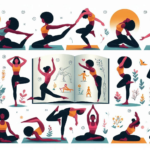Introduction
Yoga, an ancient practice with roots in India, offers a comprehensive approach to physical, mental, and spiritual well-being. For beginners, starting a yoga practice can be both exciting and daunting. This guide will help you embark on your yoga journey, providing essential tips, basic poses, and advice on creating a sustainable routine.
Why Start Yoga?
Physical Benefits
- Improved Flexibility: Yoga stretches and lengthens muscles, increasing your range of motion.
- Strength Building: Many yoga poses require you to support your body weight, which strengthens muscles.
- Enhanced Balance: Regular practice improves balance and coordination.
Mental and Emotional Benefits
- Stress Reduction: Yoga promotes relaxation and reduces stress through mindful breathing and meditation.
- Better Focus: Yoga enhances concentration and mental clarity.
- Emotional Stability: Regular practice helps manage emotions and fosters a sense of peace and well-being.
Getting Started
Choosing the Right Environment
- Find a Quiet Space: Select a peaceful area at home where you can practice without interruptions.
- Equip Yourself: A good quality yoga mat is essential. Optional items include yoga blocks, straps, and comfortable clothing.
Basic Yoga Poses for Beginners
- Mountain Pose (Tadasana)
- How to Do It: Stand tall with feet together, arms at your sides. Distribute your weight evenly across both feet.
- Benefits: Improves posture, strengthens thighs, knees, and ankles.
- Downward-Facing Dog (Adho Mukha Svanasana)
- How to Do It: Start on your hands and knees, then lift your hips toward the ceiling, forming an inverted V shape.
- Benefits: Stretches the shoulders, hamstrings, calves, arches, and hands.
- Child’s Pose (Balasana)
- How to Do It: Kneel on the floor, sit back on your heels, and stretch your arms forward, lowering your forehead to the mat.
- Benefits: Gently stretches the hips, thighs, and ankles; calms the brain and relieves stress.
- Cat-Cow Pose (Marjaryasana-Bitilasana)
- How to Do It: Start on your hands and knees, arch your back (cow), and then round your spine (cat).
- Benefits: Improves flexibility of the spine, helps with back pain, and massages internal organs.
- Tree Pose (Vrksasana)
- How to Do It: Stand on one leg, place the sole of the other foot on your inner thigh, and balance while bringing your hands to your chest.
- Benefits: Improves balance, strengthens thighs, calves, ankles, and spine.
Creating a Yoga Routine
- Set Realistic Goals:
- Begin with short sessions, 10-15 minutes a day, and gradually increase the duration as you become more comfortable.
- Consistency:
- Practice at the same time each day to build a habit. Early mornings or evenings are often ideal.
- Variety:
- Mix different poses to work various muscle groups and keep your practice interesting.
Measuring Progress
- Keep a Yoga Journal:
- Record the poses you practice, the duration, and how you feel afterward. This helps track your progress and identify areas for improvement.
- Listen to Your Body:
- Pay attention to your body’s signals. Notice improvements in flexibility, strength, and overall well-being.
- Celebrate Milestones:
- Acknowledge small achievements, like holding a pose longer or feeling more relaxed after a session.
you may also like to read: Guide to Yoga for Beginners: Transforming Lives and Strengthening Future Generations
Tips for Beginners
- Start Slow:
- Don’t rush into advanced poses. Build a strong foundation with basic poses first.
- Focus on Breathing:
- Breath control (pranayama) is a crucial part of yoga. Concentrate on your breath in each pose.
- Stay Hydrated:
- Drink water before and after your practice to stay hydrated.
- Practice Mindfulness:
- Be present in the moment and focus on your body and breath.
Conclusion
Starting a yoga practice can be a transformative journey towards better health and well-being. By following this guide, beginners can establish a strong foundation, create a sustainable routine, and experience the numerous benefits of yoga. Remember, the key to success is consistency and listening to your body. Embrace your yoga journey with an open heart and mind, and enjoy the profound impact it can have on your life.
For further guidance, consider joining a local yoga class, following online tutorials, or consulting with a certified yoga instructor. Happy practicing!












